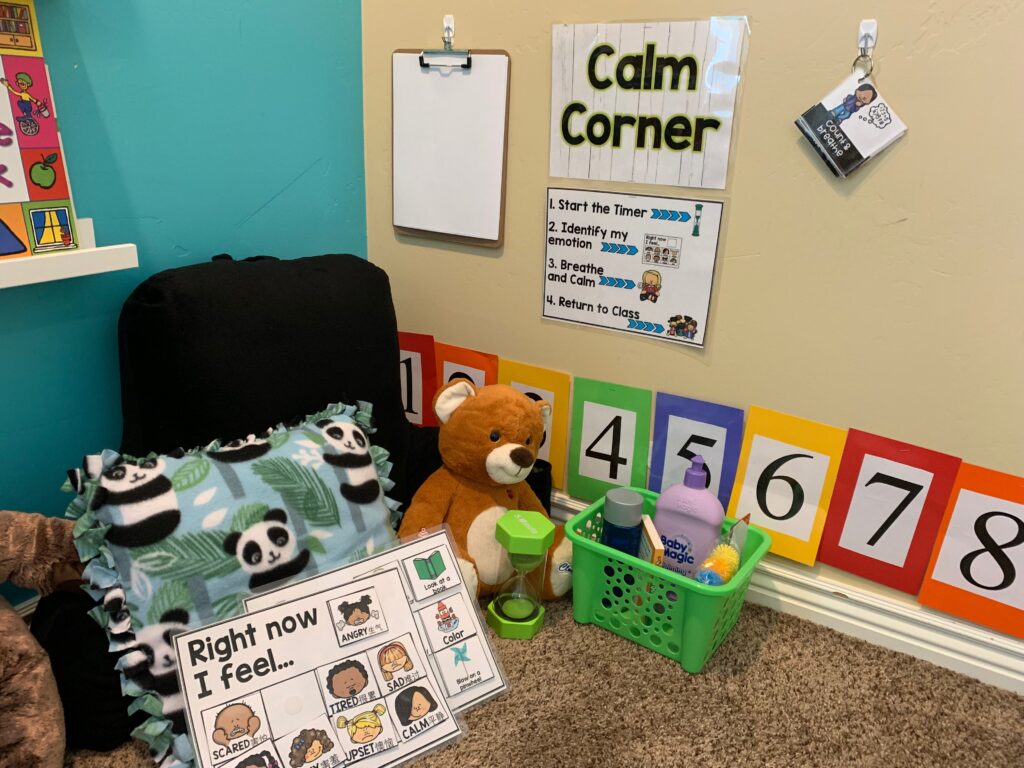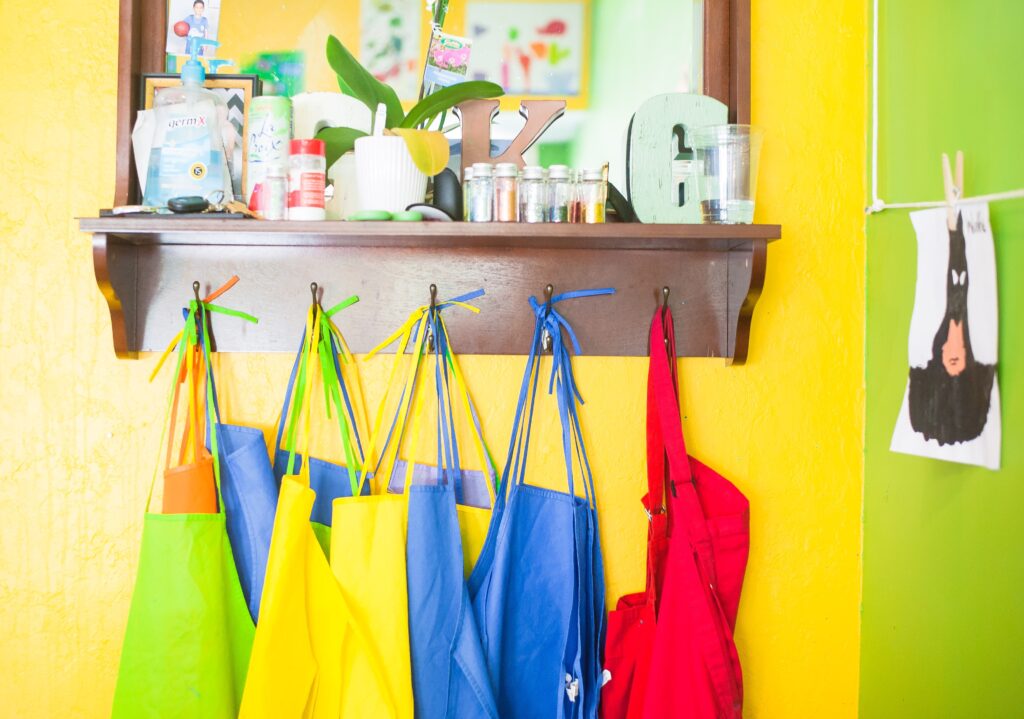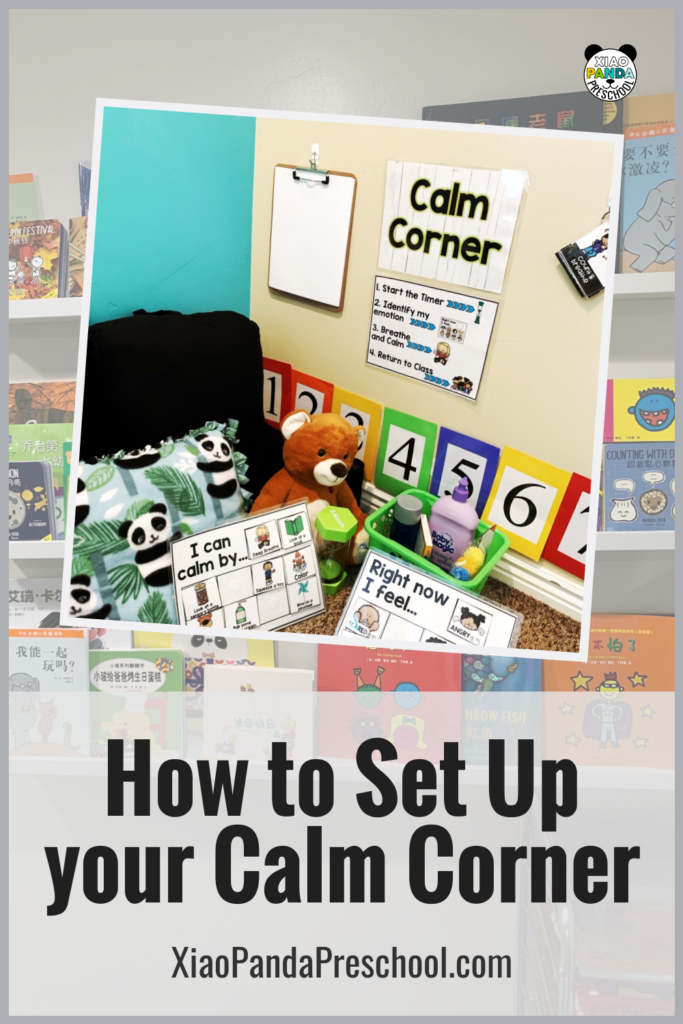Creating a “calm corner” in the early childhood classroom is an effective way to help children learn how to self-soothe and manage their emotions. This safe space gives children an opportunity to take a break and find a sense of calm when they are feeling overwhelmed or stressed. Through the teachings of conscious discipline, children can learn strategies such as deep breathing, mindfulness, and problem-solving techniques that can be used to help them regulate their emotions. A calm corner can be a powerful tool for helping children learn the skills they need to cope with their feelings.

Click Here for the printable materials I use
Why Self-Soothing Skills are Important in Early Childhood Education
Self-soothing skills are crucial for children’s emotional development in early childhood education. By teaching children how to regulate their emotions and find a sense of calm, we are equipping them with lifelong tools for success. A safe place, such as a calm corner, provides children with a dedicated space to practice self-soothing techniques.
When children are overwhelmed or stressed, they can retreat to the calm corner to take a break and regain their composure. This helps them build resilience and learn how to manage their emotions independently. It also teaches them the importance of self-care and self-awareness.
Additionally, self-soothing skills enhance children’s ability to concentrate and focus on their learning tasks. When children can calm themselves down, they are better able to engage in the classroom activities and interact positively with their peers. This leads to a more productive and harmonious learning environment for everyone.
Incorporating self-soothing skills into early childhood education not only benefits children’s emotional well-being, but also sets them up for success in school and beyond. It’s a valuable investment in their overall development.
What is a Calm Corner and How Does it Work?
A calm corner is a designated space in the early childhood classroom where children can go to find a sense of calm and self-regulate their emotions. It serves as a safe place for children to retreat to when they are feeling overwhelmed, stressed, or in need of a break.
The calm corner works by providing children with a dedicated space that is specifically designed to promote relaxation and emotional regulation. It is often equipped with soft cushions or pillows, comforting sensory items like stress balls or fidget toys, and calming visual aids such as a nature poster or a picture of a peaceful scene.
When a child enters the calm corner, they are encouraged to take deep breaths, practice mindfulness, or engage in other self-soothing activities. This helps them shift their focus away from their emotions and onto a more calm and centered state.
The purpose of the calm corner is to teach children how to independently manage their emotions and find a sense of calm. It empowers them with the tools they need to regulate their own emotions and self-soothe, ultimately promoting a positive and harmonious learning environment.
Creating a Safe and Calming Space in the Classroom
Creating a safe and calming space in the classroom is essential for the success of a calm corner. This space should be intentionally designed to promote relaxation and emotional regulation. Start by selecting a quiet corner of the room that is away from distractions. Use soft and comforting materials such as plush cushions or pillows for seating. Consider adding soothing elements like nature-inspired posters or tranquil artwork on the walls. Create a peaceful atmosphere with dim lighting and soft music. Make sure the area is well-organized and clutter-free to minimize sensory overload. Encourage children to take ownership of the space by involving them in its setup and maintenance. By creating a safe and calming space, you are setting the foundation for children to find solace and develop essential self-soothing skills. I use these printables for my calm corner.
Tools and Materials to Include in the Calm Corner
Creating a calming and safe place in the classroom is essential for the success of a calm corner. In order to promote relaxation and emotional regulation, it is important to provide children with the necessary tools and materials. Some items to include in the calm corner are soft cushions or pillows for comfortable seating, stress balls or fidget toys for sensory input, and calming visual aids such as nature posters or pictures of peaceful scenes. Other helpful tools may include books or calming music to help children relax. By providing these materials, children can engage in self-soothing activities and find comfort in the calm corner. It is important to regularly assess and update the materials in the calm corner to ensure that they meet the needs of the children in the classroom. Creating a well-equipped calm corner will support children in developing their self-soothing skills and emotional regulation abilities.
Strategies for Teaching Children to Use the Calm Corner for Emotional Regulation
Now that you have created a calm corner in your early childhood classroom, it’s important to teach children how to effectively use this space for emotional regulation. Here are some strategies to help you do just that.
- Model and demonstrate: Show children how to use the calm corner by modeling appropriate behaviors yourself. Take breaks in the calm corner when you feel overwhelmed or stressed and explain to the children what you are doing and why. By modeling self-soothing techniques, you are providing a visual example for children to follow.
- Teach specific strategies: Introduce children to various self-soothing techniques they can use in the calm corner. This can include deep breathing exercises, guided imagery, or mindfulness activities. Teach them the steps and encourage them to practice these techniques when they need to calm down.
- Reinforce positive behavior: When a child uses the calm corner successfully to regulate their emotions, provide positive reinforcement. Praise them for taking responsibility for their emotions and making the choice to use the calm corner. This positive reinforcement will motivate them to continue using the space in the future.
- Use visual cues: Place visual reminders or cue cards in the calm corner that outline the steps for self-soothing. This will help children remember and follow the techniques they have learned. Visual cues can be especially helpful for young children who may not yet be able to read or understand written instructions.
- Practice problem-solving: Teach children how to use the calm corner as a space for problem-solving. Encourage them to reflect on what triggered their emotions and think of possible solutions. This will help them develop their problem-solving skills while also promoting emotional regulation.
Remember, teaching children how to use the calm corner for emotional regulation is an ongoing process. Be patient and consistent, and provide them with the support and guidance they need to develop these important skills.

Incorporating Conscious Discipline Techniques in the Calm Corner
Incorporating Conscious Discipline techniques in the calm corner can greatly enhance its effectiveness in promoting self-soothing and emotional regulation. Conscious Discipline is an approach that focuses on teaching children important life skills, such as problem-solving and self-control, in order to develop their social-emotional well-being.
One technique that can be used in the calm corner is the use of affirmations. Displaying positive affirmations in the space can help children reframe their thoughts and foster a more positive mindset. Another technique is the use of visual cues, such as emotion cards, to help children identify and express their emotions effectively. Additionally, incorporating mindfulness activities, such as guided breathing exercises or yoga poses, can help children become more self-aware and grounded. By incorporating Conscious Discipline techniques in the calm corner, children are provided with additional tools and strategies to effectively manage their emotions and develop important life skills.
Conclusion
In conclusion, creating a calm corner in the early childhood classroom is a powerful tool for teaching children self-soothing skills and emotional regulation. By providing a safe and calming space, children have the opportunity to take a break and find a sense of calm when they are feeling overwhelmed or stressed. Through the teachings of conscious discipline, children can learn strategies such as deep breathing, mindfulness, and problem-solving techniques that can be used to regulate their emotions.
Self-soothing skills are crucial for children’s emotional development and overall success in early childhood education. They empower children to manage their own emotions, develop resilience, and focus on their learning tasks. A well-equipped calm corner, designed with soft cushions, calming visual aids, and sensory items, creates an environment that promotes relaxation and emotional regulation.
By modeling appropriate behaviors, teaching specific self-soothing strategies, and reinforcing positive behavior, teachers can effectively teach children how to use the calm corner for emotional regulation. Incorporating conscious discipline techniques, such as affirmations and mindfulness activities, further enhances the effectiveness of the calm corner.
Overall, the calm corner is a valuable investment in children’s emotional well-being and sets them up for success in school and beyond. By teaching self-soothing skills, we are equipping children with lifelong tools for managing their emotions and finding a sense of calm in any situation.

